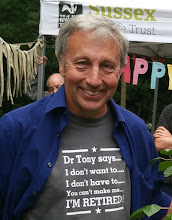Plans for a significant new town north east of Henfield threaten to
concrete over a huge swathe of cherished Sussex
countryside. Below I reproduce an
excellent article written by Jane Simmons, a local resident. A wide range of wildlife will be affected by
this proposal (not to mention the devastated landscape, over-crowding and
congestion) but this current article looks at the issue from the perspective of
Barn Owls, one of our more threatened bird species.
The peer responsible for the Government’s planning reforms wants
to build a new town on countryside of ‘National Importance’ to Barn Owls -
contrary to the guidelines set out in his own legislation.
Mayfield Market Towns wants to build 10,000 homes around Wineham
and Twineham, on countryside straddling the River Adur Corridor. However, Colin
Shawyer, former Director of the Hawk and Owl Trust and founder of the Barn Owl
Conservation Network, says the area plays a vital part in a UK-wide Species
Recovery Network.
“These sites are important not only locally,” he says “but
also regionally and nationally because this is all part of a UK wide project
to restore the failing Barn Owl population. It is important to see this as a
link in a chain. Barn Owls are very sedentary birds so they are not going
to fly very far to new sites. In fact they won’t leave their home ranges - they
will just not breed within them. Then, as the habitat goes, eventually the
population dies out.”
One of Mayfield Market Town’s Directors, Lord Matthew Taylor, was
responsible for reviewing the Government’s National Policy Planning Framework
two years ago. These guidelines advise planners to ‘identify and map
components of local ecological networks,’ and ‘promote the preservation,
restoration and re-creation of priority habitats’ to protect vulnerable
species like the Barn Owl.
The Barn Owl is a Schedule 1 protected species and, due to its
fragile population, has been closely monitored for many years. Figures compiled
for the Sussex Ornithological Society show that more than 10% of West Sussex’s Barn Owls depend on this area. And
according to Mr Shawyer, the loss of habitat here would also affect many more
birds further along the river.
“You can’t integrate Barn Owls into development schemes
however much green space you put in. You can try and recreate it, but it won’t
work because in order to have a good viable Barn Owl population you need
habitat stretching over a twenty km stretch of river – you can’t fragment it
with housing developments. Barn Owls will no longer survive in those areas. If
an area of houses encroaches onto the River Adur corridor and within about one
and a half km either side then you are not going to hold that population
steady.”
But Lord Taylor’s fellow Mayfield Director, Peter Freeman has
confirmed that Mayfield Market Towns is pressing on with its plans.
“We are now embarking on the formal planning application process,
which will involve more detailed work on many aspects including ecology and
flooding,” he says. “The work that our consultants have carried out to date
leaves us with little doubt that there are no show stoppers.”
The owls in this area have been monitored for many years by Dr
Barrie Watson who is a former President of the Sussex Ornithological Society.
He holds a licence to ring them and checks the boxes each year to count and
weigh the young to see how the population is progressing.
“The numbers of pairs breeding may vary from year to year
according to the food supply,” he says. “We monitor the nest boxes at the large
young stage, when it is very safe to disturb them. We have a lot of boxes
in barns as well as on trees. This is a brilliant habitat for Barn Owls.
It is nicely away from the main road, it has plenty of low lying fields, and
the eastern arm of the River
Adur Valley
has lots of rough banks and grassy margins for voles and mice, which provide
food for the owls.
“The numbers of Barn Owls went down catastrophically from the 1930s
– probably with the intensification of agriculture. The fields tended to be
cultivated right up to the barbed wire fence instead of having a grassy
headland at the end and the modern barns aren’t quite so friendly for owls -
they don’t have the dark nooks and crannies for them to nest.
“We devised a species action plan for West
Sussex, setting out things we would like to see to improve the
population. We’ve put up a lot of nest boxes on trees and in agricultural
buildings and farmers have been paid to leave grassy margins. I’m appalled to
hear about this development plan; I have lived in Sussex
all my life and was brought up in a rural area. I think we need nature and open
spaces – I want some countryside left please.”
Michael Nailard is Chairman of the Hurstpierpoint Flora and Fauna
Group which has put up a number of Barn Owl boxes in the countryside nearby.
“Development would absolutely destroy all the work we’ve done,” he
says. “Owls and bats need wide open spaces to survive. Without the countryside
you won’t get these species surviving – they’ll be gone and our children will
never know them.
“It makes me very cross. A pocket nature reserve or a wildlife
corridor is no substitute for open countryside and I try to impress that on all
the council officials and developers that I talk to. But they don’t seem
interested – ecology is at the bottom of their list of priorities I’m
afraid.”
